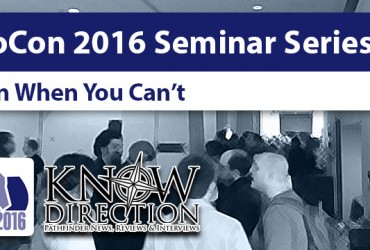A 2 x 2 room, an Orc, and a pie…
The simplest and most condensed encounter imaginable. There’s a location – a 10-ft. square room. There’s an obstacle – the Orc. And there’s a reward – the pie. Presumably that’s all you need for an adventure. And honestly, that’s really all there is to designing an encounter. So that’s it, right? We’re done? Not quite…
The RPGs have gotten a lot more nuanced since the days of Blackmoor. And 2×2+Orc+Pie is no longer as like gangbusters as it once was, if indeed it ever was really all that thrilling in the first place. Instead, it’s more of a simple model to showcase encounter design components. So let’s go into it shall we?
So what do we have? An encounter area, an obstacle, and a goal. Those are the bare minimum requirements for an encounter. It’s a simple enough recipe. It’s a staple. Kind of like bread, peanut butter, and jelly. But doesn’t that get boring after a while? Well just like any recipe, the devil is in the details.
Location, location, location!
Just like business, real estate, and agriculture a successful encounter has its foundations in a good location. What determines a good location is entirely dependent on the type of encounter you’re running, what you’re going for, and how challenging you want it to be. Think of an encounter’s location as the set and backdrop on a stage. It’s not the focus of scene, that’d be the actors on the stage. But a good set and backdrop can do nothing but enhance the drama.
So what makes for a good encounter location? Simply one that makes the encounter more interesting, ideally one that both changes the normal dynamic of a combat and ties into the theme or narrative of your adventure. Traps, hazards, or set pieces that can be interacted with are all good examples of elements that make encounters interesting. Think of the scene from The Fellowship of the Ring where Frodo & Friends are down the crumbling steps through Moria. The floor falls away to an endless blackness. The ground quakes beneath their feet. Arrows are whizzing through the air. It’s absolutely epic. Would it have been as cool had the Mines of Moria turned out to be a series of indistinguishable corridors of featureless gray stone? Nope.
What Doesn’t Kill You…
Next up is the obstacle. More often than not we’re talking about a monster(s), or NPC(s), or trap(s) or some combination thereof. What that combination is and how challenging those particular elements I leave to you and your campaign. But I do want to remind you that the CR of an encounter should take into account the CR of any critters or baddies as well as any difficulties that the environment might hold. A fight against a CR 5 Water Elemental in the middle of a town is a much lower than a fight against that same Elemental in the middle of the ocean, for example.
The same goes for complexity. If you’re rocking an encounter with multiple high-level baddies with several pages of SLA’s or unique rules, chances are you’re going to have your hands full dealing with that, let alone anything that special environmental rules might add on top of that. Likewise, if you’ve devised some awesome trap or hazard for your encounter, try and keep the more complex baddies out of the picture if at all possible.
Of course, the greatest ideal is when you marry special rules for your environment and your baddies. Say, when you have a fight with a Dragon Disciple with Draconic Reservoir in with a room with vents that spontaneously spew forth jets of fire.
To the Victor Goes the Spoils
Depending on where this encounter fits in your overall game this last element, the goal, could be all important or entirely trivial. The trick is to suss out which and not derail your campaign or bury the lead. Usually the goal or prize at the end of an encounter is dictated by the adventure. A clue that leads to the next series of events. Or it might just be a prize for having survived. My favorite tweak of this particular element is reserved for when my PCs decide they don’t want to follow my breadcrumbs.
Say the PCs are supposed to be investigating a murderous cult in the city’s Market District but they want to schlep around the Dockyard. Oops! They triggered a random encounter and get waylaid by belligerent sailors. Upon defeating the ruffians, they search the bodies (obviously) and find a note with a PC’s name on it and some wooden chits that a DC 10 Knowledge (Local) can be identified as barter script for a *gasp* emporium in the Market District…
Tying It All Together
I was able to put much of the above theorizing into practice when writing PFS #6-20: Returned to Sky. At their most basic, most PFS Scenarios are a series of connected encounters that are undertaken in a linear fashion to tell a short narrative. Returned to Sky was no exception. But the combat encounters in this adventure are – I think – some good examples of how you can skew your encounter design heavily one way or another and still come up with a workable and interesting product.
The first combat is against a Technic League agent (a whip wielding magus) and his cronies (a sorcerer and some robots). I put two arcane spellcasters and monsters of an uncommon subtype in the same encounter which meant that I didn’t want any sort of environmental conditions to further complicate matters. The magus’ rules for AoOs, Spell Combat, and Spell Strike alone is enough for even proficient GM’s. So the battle is set in a tavern with a narrow choke point (the tavern’s door) initially separating the PCs from their enemies. This simple set up allows for a few interesting tactical decisions on the part of the PCs. Should they pile out the door, sneak around out back for a flank, exchange missiles and spells through the door and windows?
The next encounter is where my developer let me go a little crazy with the design. And I definitely appreciate both John Compton’s trust that I could pull it off as well as development to refine what was great about it. In contrast to the previous encounter that loaded up all the complexity onto the enemies, this one was entirely environmental hazards. The PCs enter a portion of a crashed space ship and simultaneously trigger what amounts to a Reverse Gravity trap and defensive turrets. The directionality of the trap changes by the round so PCs are slammed against the floor, ceiling, and walls unless they have some way to overcome the effects of the trap. Meanwhile, the defensive turrets are blazing away with the equivalent damage of three Scorching Rays per round. It can get nasty for an unprepared party.
So that’s it for this week. So what do you think about designing encounters yourselves? Do you like doing it or would you rather copy/paste from a module? If you’d like to add to the discussion you can do so in the comments section below or on the forums!






